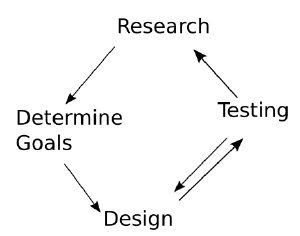A Students Guide to Interaction Design
Mitarbeit willkommen. Bitte beachtet dass eure Beiträge unter Creative Commons Lizenz stehen werden.
Please contribute. Please note that this work and you edits are licensed under a Creative Commons Licence:
This work is licenced under Creative Commons Attribution-ShareAlike 3.0 Unported.
Preface
goals: This guide is aimed at students who want to develop new products, services, software or websites. We cover the whole interaction design process in a brief and understandable way and enable students to understand the most important terms so that they can read the literature.
No-Goals: Include material that is non-relevant for practical work.
Foundations
Iterative Design Process
 The iterative design process helps you to structure your design process. It is an easy to use cycle model.
Doing the steps helps you to understand your users by doing research. So you don't design for non-existing needs or interfaces nobody can use. It helps as well to be more creative at the end: by dealing with your users, you will see your designs from a new perspective and so develop new ideas.
The iterative design process helps you to structure your design process. It is an easy to use cycle model.
Doing the steps helps you to understand your users by doing research. So you don't design for non-existing needs or interfaces nobody can use. It helps as well to be more creative at the end: by dealing with your users, you will see your designs from a new perspective and so develop new ideas.
Usability Goals
The usability goals are a small collection of basic user needs. They are broad, but you will have no trouble to understand them.
Utility
If your product's functionality matches the needs of your users and enables them to reach their goals it has a good utility.
You can find out your users needs and goals by doing "user research" which means that you apply some research methods. One of these methods is doing a special kind of interview with some users. I will cover this technique in a latter chapter.
Learnability
A good learnability exists if the users you target can use your product without putting a lot of effort learing. This is especially important for the very basic functions.
Ideally users don't have to bother about new concepts and unknown terms.
Learnability is what will be the first thing that comes into your mind if you think about interaction design. Paradoxically it is a principle that is ignored in many products: Industry often uses a lot of functions that dimish learnability and many student projects ignore learnablity and focus on efficiency. You can improve the learnability of your application by learning common principles of design like "visibility" or "consisteny" and by testing your ideas with your users. Material for lerning this will be provided in latter chapters.
Efficiency
Your product has a good efficiency if the user can archive a high productivity. This simply means he/she can do more in less time once it is known how one uses the product. Efficiency can be archived with optimizing the ways the functions are accessed and with providing additional ways of interaction like keyboard shortcuts. Efficiency is important, but in my experience it is easiely over-emphasized as one does not need to learn one's own designs and efficient stuff feels just great. But a command line interfaces or gestural interaction are cool and really efficient if you can use it but they need to be explicitly learned before they can be used. And the difficulties of learning are often underestimated by interaction design beginners.
Safety
Safety is protecting the user and his/her creations from undesired outcomes. Very basic is that you provide a product that does not crash and destroys the users data by doing so.
You should as well prevent that the user selects data-destroying functions by accident. E.g. putting the "save" and the "close" entry close to each other in a menu will cause data loss: if the user wants to save, he may press "no" after a dialog window appears: "don't bother me now. I want to save my data!" - and the data is lost, "close" was selected by accident and the dialog-window that was dismissed by choosing "no" was the final warning.
Even if you prevent accidental actions the users data is not save. Users may misunderstand the name of an action or just try out what the result will look like. Therefore you should provide an undo-facility. This means the user can do an action and if it turns out that this has been a bad idea it can be undone. This is a great feature that demands a bit of thinking when the code is written but it is worth it. As a side effect your application becomes more learnable as well: users are able to learn by doing without any worries.

